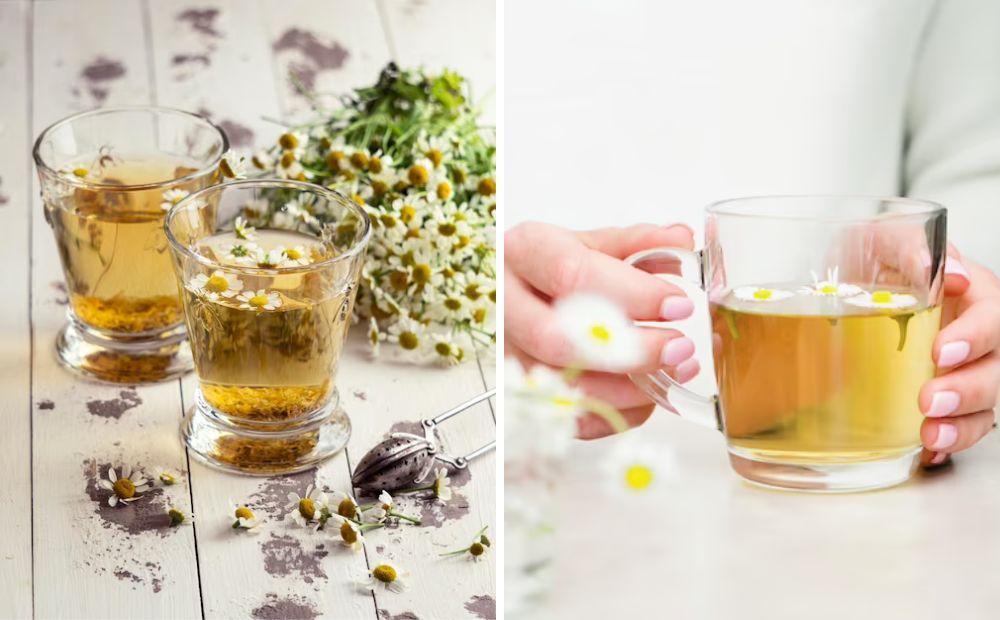Chamomile tea, a popular herbal infusion known for its calming properties, is enjoyed by many for its unique taste and health benefits.
This tea is made from the dried flowers of the Chamomile plant, which is native to Western Europe and Northern Africa.
People drink Chamomile tea for various reasons. Some appreciate the delicate, slightly sweet flavor that is often likened to apples.
Others enjoy chamomile tea as a caffeine-free alternative to black or green tea.
However, the most common reason people drink Chamomile tea is for its potential health benefits.
Chamomile tea is often associated with promoting sleep and relaxation. It's a common choice for those looking to unwind after a long day or those struggling with sleep issues.
Additionally, Chamomile tea is believed to have anti-inflammatory and antioxidant properties, which can support overall health.
For a deeper understanding of Chamomile tea, its taste, and benefits, check out this comprehensive guide by Kayla Itsines.
So, whether you're a long-time Chamomile tea drinker or just considering giving it a try, read on to learn more about this soothing beverage.
3 Key Takeaways:
- Chamomile tea is a popular herbal infusion with a unique, slightly sweet flavor that is often likened to apples, offering a soothing and refreshing drinking experience.
- Beyond its delightful taste, Chamomile herbal tea is associated with numerous health benefits, including promoting sleep and relaxation, supporting digestive health, and improving skin health.
- Making Chamomile tea at home is a simple process, and with a few tips and tricks, you can enhance its flavor to suit your personal taste preferences.
What is Chamomile Tea?
Chamomile tea is a herbal infusion made from the dried flowers of the Chamomile plant.
The name "chamomile" comes from the Greek words "khamai," meaning on the ground, and "melon," meaning apple—reflecting the plant's low-growing habit and the apple-like scent of its flowers.
The use of Chamomile has a long history that dates back to ancient civilizations.
The Egyptians, Romans, and Greeks used Chamomile flowers in various ways, including as a medicinal herb, a flavoring agent for drinks and foods, and even for cosmetic purposes.
In the context of tea, Chamomile has been used for centuries. It was a popular choice in medieval Europe, and its popularity has only grown over time.
Today, Chamomile tea is enjoyed worldwide and is especially known for its calming and soothing properties.
Making Chamomile tea is a simple process. The dried Chamomile flowers are steeped in hot water for several minutes.
The resulting infusion is a golden-colored tea with a delicate, slightly sweet flavor and a delicately floral herbal tea aroma.
For a more detailed look at how Chamomile tea is made, check out this article by JING Tea.
What Does Chamomile Tea Taste Like?

Remember, while Chamomile tea has many potential health benefits, it's not a substitute for professional medical advice or treatment. Always consult with a healthcare professional if you have any health concerns.
Describing the taste of Chamomile tea can be a bit challenging as it's quite unique and unlike most other teas.
So what does Chamomile tea taste like? Most people agree that Chamomile tea has a delicate, slightly sweet flavor with a hint of floral notes.
The taste of Chamomile tea is often described as reminiscent of a crisp apple, which is not surprising given that the word "chamomile" itself is derived from the Greek words for "ground" and "apple."
This apple-like flavor is subtle and not overpowering, making Chamomile tea a light and refreshing beverage.
In addition to its apple-like taste, Chamomile tea also has a gentle earthiness that adds depth to its flavor profile. Some people also detect a hint of honey-like sweetness, especially in the aftertaste.
This combination of flavors—apple, earthy, and honey—gives Chamomile tea its distinctive and soothing taste.
When compared to other common flavors, Chamomile tea is less robust than black tea and lacks the grassy notes of green tea.
It's also less tangy than hibiscus tea and less minty than peppermint tea. Instead, Chamomile tea offers a unique flavor that is mild, calming, and slightly sweet.
It's worth noting that the taste of Chamomile tea can vary depending on how it's brewed.
Steeping the tea for a longer time will result in a stronger, more pronounced flavor, while a shorter steeping time will yield a milder taste.
In the end, the taste of Chamomile tea is a personal experience that can be influenced by many factors, including the quality of the tea, the brewing method, and individual taste preferences.
But no matter how you describe it, there's no denying that Chamomile tea offers a soothing and enjoyable drinking experience.
How to Prepare Chamomile Tea
Making Chamomile tea at home is a simple and straightforward process. Here's a step-by-step guide:
Choose Your Chamomile: You can use either fresh Chamomile flowers or dried ones. Dried Chamomile flowers are more commonly used and are available in most grocery stores or online.
Measure Your Chamomile: For each cup of tea, use about one tablespoon of dried Chamomile flowers or two tablespoons of fresh flowers.
Heat Your Water: Bring water to a boil. For the best flavor, use filtered water if possible.
Steep Your Tea: Place the Chamomile flowers in a teapot or a tea infuser. Pour the hot water over the flowers and let them steep for about 5 minutes. The longer you let the tea steep, the stronger the flavor will be.
Strain and Serve: Strain the tea into a cup. Your Chamomile tea is now ready to enjoy!
Tea Bag: You can buy chamomile tea in tea bags and for a milder tea, use a single tea bag. For a stronger flavor, experiment with two chamomile tea bags.
To enhance the flavor of your Chamomile tea, consider these tips:
Add Sweeteners: If you prefer a sweeter tea, consider adding a bit of honey or agave nectar. These natural sweeteners can complement the apple-like flavor of Chamomile tea.
Include Other Herbs: Chamomile tea pairs well with other herbs like mint or lavender. Adding these herbs can create a more complex flavor profile.
Add a Slice of Lemon: A slice of lemon can add a refreshing citrus note to your Chamomile tea and enhance its natural flavors.
Remember, the key to a great cup of Chamomile tea is to experiment and find what tastes best to you.
When trying chamomile tea for the first time, it's important to be mindful of potential allergic reactions or side effects, although these occurrences are rare. As with any other herbal teas, exercising caution is recommended.
Enjoy the process of brewing your tea and savor the calming and soothing experience of drinking it.
Health Benefits of Chamomile Tea
Chamomile tea is not just a soothing and delicious beverage; it's also packed with health benefits. Here are some of the key health benefits associated with drinking Chamomile tea:
Promotes Sleep and Relaxation: Chamomile tea is well-known for its sleep-inducing properties. It contains an antioxidant called apigenin, which binds to certain receptors in your brain that may promote sleepiness and reduce insomnia.
Supports Digestive Health: Chamomile tea may help with various digestive problems, including indigestion, nausea, and gas. It's often used as a natural remedy for irritable bowel syndrome (IBS) and ulcers.
Boosts Immune Health: Chamomile tea is rich in antioxidants, which can help strengthen your immune system and protect against common illnesses like the cold and flu.
Improves Skin Health: Due to its anti-inflammatory and antioxidant properties, Chamomile tea can be beneficial for skin health. It may help soothe skin irritations, reduce acne, and promote a healthy glow.
Manages Blood Sugar Levels: Some studies suggest that Chamomile tea can help regulate blood sugar levels, making it a good choice for people with diabetes.
Scientific evidence supports many of these health benefits.
For instance, a study published in the Journal of Advanced Nursing found that new mothers who drank Chamomile tea for two weeks reported better sleep quality compared to a group that did not drink the tea.
They also had fewer symptoms of depression.
Another study published in the Journal of Agricultural and Food Chemistry found that Chamomile tea might have the potential to lower blood sugar levels in people with diabetes.
The study found that consistent consumption of Chamomile tea could potentially slow down the progression of diabetes complications.
Remember, while Chamomile tea can contribute to good health, it should not replace any medical treatments or medications you're currently on.
Always consult with a healthcare professional before starting any new health regimen.
FAQs About Chamomile Tea
Here are some frequently asked questions about Chamomile tea:
Can I drink Chamomile tea every day?
Yes, it's generally safe to drink Chamomile tea daily. However, like any food or drink, it's important to consume it in moderation. If you're pregnant, nursing, or have any health conditions, it's best to consult with a healthcare professional before adding Chamomile tea to your daily routine.
Does Chamomile tea have caffeine?
No, Chamomile tea is a caffeine-free herbal tea. This makes it a great choice for those who are sensitive to caffeine or looking for a calming beverage to drink before bed.
Can Chamomile tea help with anxiety?
Yes, Chamomile tea is often used as a natural remedy for anxiety. It contains an antioxidant called apigenin, which is believed to have calming effects on the brain. However, more research is needed to fully understand the potential benefits of Chamomile tea for anxiety.
How long should I steep Chamomile tea?
For the best flavor, it's recommended to steep Chamomile tea for about 5 minutes. However, you can adjust the steeping time to your preference. A longer steeping time will result in a stronger flavor, while a shorter steeping time will yield a milder taste.
Can I use Chamomile tea for skin care?
Yes, Chamomile tea can be used in skin care. Its anti-inflammatory and antioxidant properties can help soothe skin irritations, reduce acne, and promote a healthy glow. You can use Chamomile tea as a facial rinse or add it to your bath water for a soothing soak. Remember, while Chamomile tea has many potential health benefits, it's not a substitute for professional medical advice or treatment. Always consult with a healthcare professional if you have any health concerns.
Conclusion
In this article, we've explored the world of Chamomile tea, a soothing and flavorful beverage enjoyed by many around the globe. We've delved into its origins, how it's made, and most importantly, what it tastes like.
With its unique apple-like flavor and subtle sweetness, Chamomile tea offers a refreshing and calming drinking experience.
We've also looked at the numerous health benefits associated with Chamomile tea, from promoting sleep and relaxation to supporting digestive and skin health.
Scientific research supports many of these benefits, making Chamomile tea a great addition to a healthy lifestyle.
Finally, we've answered some frequently asked questions about Chamomile tea, providing you with a comprehensive understanding of this popular herbal tea.
Whether you're a long-time tea drinker or new to the world of herbal teas, we encourage you to try Chamomile tea.
Its unique flavor and potential health benefits make it a worthwhile addition to your tea collection.
So, why not brew a cup of Chamomile tea today and experience its soothing and delightful taste for yourself?
Enjoy!
Need a new tea kettle for your chamomile tea addiction? Check out our blog post for our top 5 picks.











